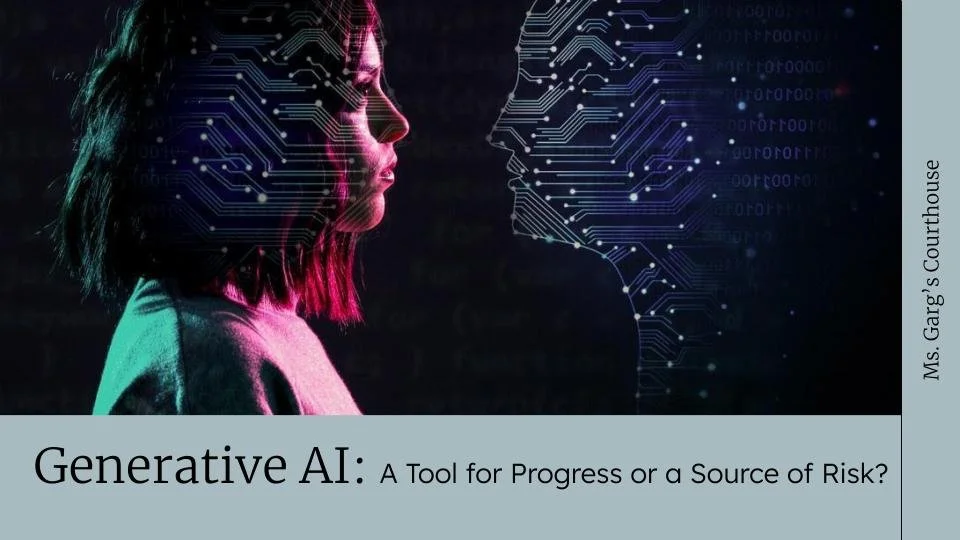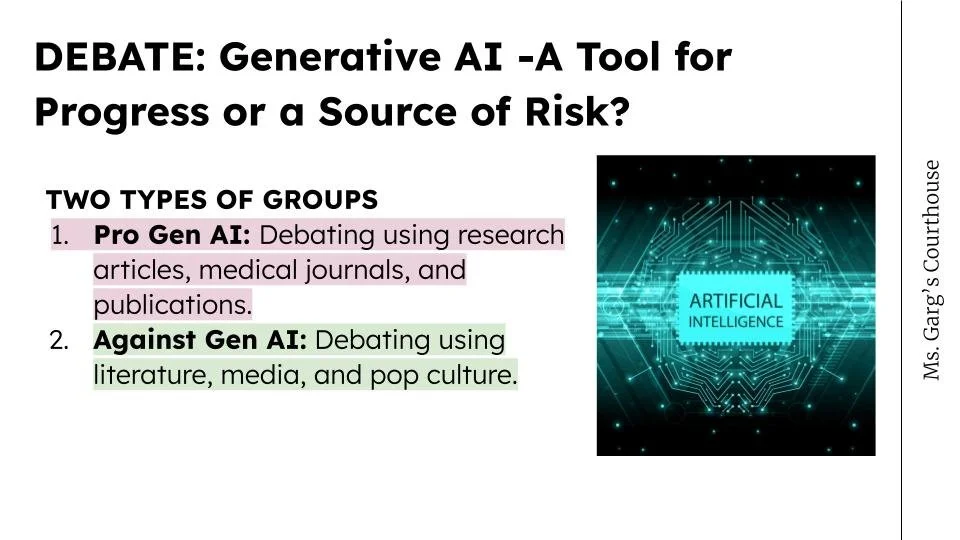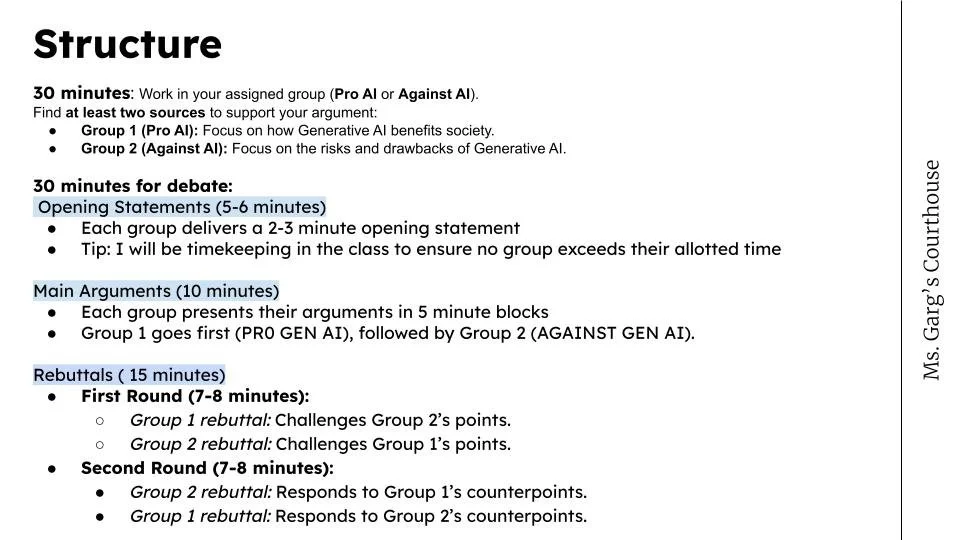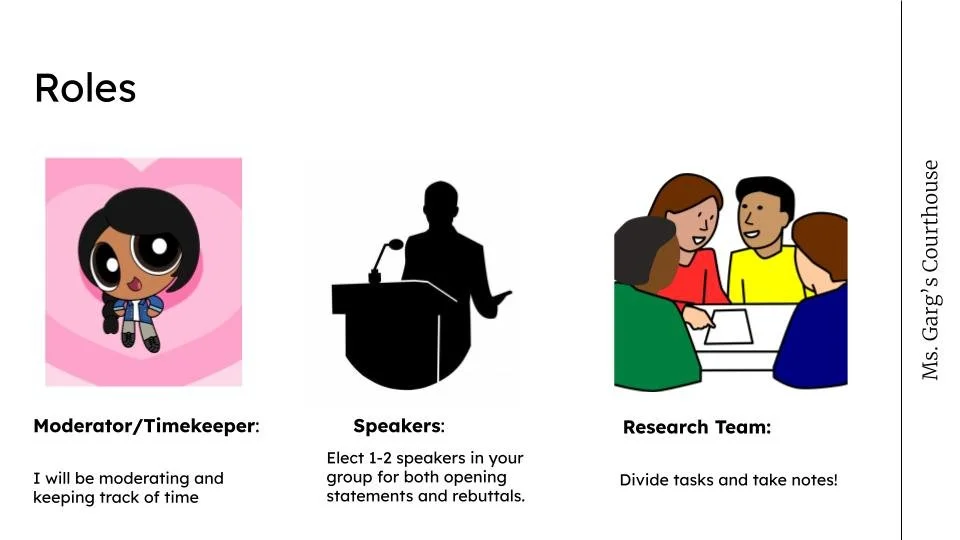
Nithya Garg
E-portfolio
Critique of AI in the Classroom
The Inquiry Dilemma: Can Generative AI Enhance or Impede Inquiry-Based Pedagogy
The rapid entrance of AI into our modern life parallels the disruptive innovation of the calculator. Generative AI (deep-learning models that can generate high-quality text, images, and other content based on the data they were trained on) writing software presents a unique challenge for English educators, as our current pedagogical choices have significant impact on our student's writing proficiency or lack thereof. Policy and technology rarely move at the same speed, and as educators we need to consider how this technology impacts our secondary classrooms, and whether we have the tools to apply it thoughtfully. Can AI bolster a new generation of inquiry-based problem solvers, or will it create an irredeemable atrophy in critical thinking and writing skill development? How can we embed AI literacy if it is an inevitable resource for students? And does AI truly benefit students?
I address these questions as I critically examine the use of generative AI software in secondary English classrooms, focusing on its influence within inquiry-based pedagogy and writing development. I begin with exploring how AI and problem-based learning (PBL) can be utilized to create an engaging, collaborative instructional approach within the classroom. As AI becomes embedded in classroom practices, AI literacy instruction must be comprehensive to ensure that students and educators engage with the technology critically and effectively. Consequently, I will address the impact of Generative AI on students' confidence in their writing skills, arguing that this will influence key pedagogical decisions as educators adapt to these new technologies. The potential synergy between Generative AI and inquiry-based education is possible but understanding the impact it will have on student writing development in the ELA classroom is essential.
Inquiry-based learning can be defined as "an array of classroom practices that promote student learning through guided and, increasingly, independent investigation of complex questions and problems, often for which there is no single answer" (Lee et al., 2004, p. 9). Nova Scotia’s current push for inquiry based learning reflects a belief that student driven inquiry will encourage greater engagement and independence in our students. When exploring how this philosophy can be applied in the ELA classroom with the help of AI writing software, Professor Sean Wiebe from the University of Prince Edward Island emphasizes that such tools can promote active learning. He believes generative AI tools can foster micro-inquiries, encouraging valuable discussions and collaboration within the classroom. In an example, he starts with asking students to identify a prompt by inputting their, “I don’t know why...” statements into a Chat GPT search engine. Students reimagine better ways of approaching the problem in pairs or in groups, using the prompting information as a jump off point (Wiebe, 2024). Rather than shaping the argument itself, AI prompts create opportunities for collaboratively developed thought experiments, which can be carried into more personalized writing assessments. Using AI to encourage conversational problem solving can create more dialectic means of navigating inquiry-based learning in our classrooms.
Developing AI literacy across the secondary classroom, for students, educators, and policymakers alike, is imperative as we move toward the inevitability of AI usage. AI literacy is not just a technical skill but a critical component of inquiry-based learning, as students must learn to use AI tools thoughtfully and ethically to navigate real-world problems. "Students need to learn how to use AI technologies judiciously, as well as to discriminate between ethical and unethical practices" (Robinson et al., 2020). This includes teaching students to recognize AI's potential biases, limitations, and ethical implications, all of which are crucial when engaging with the kinds of complex problems typically explored in inquiry-based learning. In a survey with pre-service English teachers at a Turkish university, they expressed that, "teacher education programs should provide courses on AI technologies to equip pre-service teachers with the knowledge and skills necessary to effectively utilize AI in language education. In this way, future teachers can embrace innovative teaching methods and create engaging learning environments" (Yetkin & Özer-Altınkaya, 2024, p. 11). A study on the appropriate usage of AI technology stated that, "the assessment of prerequisite knowledge (such as critical thinking, disciplinary knowledge, inquiry-based questioning skills, and AI literacy) is needed to inform teachers if their students are ready to use ChatGPT and MidJourney in learning" (Chiu, Moorhouse, et al., 2023). Both the appropriate usage of this technology and greater guidelines on how to assess whether students are mature enough to employ this technology will influence the direction of inquiry-based learning within the contemporary classroom landscape.
Despite the proposed benefits that Generative AI can have on encouraging inquiry and collaborative solutioning in the classroom, hearing from students directly on their experience with this technology is vital. From a sample group of high-school students in United States, one student said that, “I was never formally taught grammar rules, so I use Grammarly a lot because I don't want to make mistakes” (Higgs, J. M., & Stornaiuolo, A., 2024 p. 640) Other students are using AI for more higher order thinking and reasoning, stating using generative AI “acts like a catalyst for my thoughts,” a viewpoint shared by others who similarly reported that AI offered “a spark to go off from” and “ideas to go off of for my writing” (Higgs, J. M., & Stornaiuolo, A., 2024 p. 640). The disparity between students using AI technology for foundational skill gaps in writing and those who use it to catalyze their thoughts is one that will be relevant in upcoming research. If students do not have a grasp over the foundation of their writing skills, inquiry-based learning cannot be effective. Integrating AI writing tools in the classroom assumes that students already have the skills needed for inquiry and that they have developed higher-order thinking skills. It is important to consider how AI may erode students' confidence and desire to improve their writing over time, along with the resulting psycho-social impact.
The usage of Generative AI writing software in secondary English classrooms within inquiry-based pedagogy should be considered carefully. AI prompting tools can be very useful to bolster collaborative problem solving and discussion-based reasoning, which can be used to direct subsequent writing assessments. It will require embedding more comprehensive AI literacy skills amongst students and educators in order to develop ethical usages of AI in the classroom. It is also important to maintain a critical perspective on how AI is affecting our students both academically and socially, assessing how AI tools influence students' confidence in their writing abilities. As a future educator myself, I am left with more questions than answers with regards to the role of AI in the ELA classroom. Just as we would not offer a scientific calculator to a 3rd grader, the use of AI in the secondary classroom should be approached with equal careful consideration.
References
Chiu, T. K. F. (2023). The impact of generative AI (GenAI) on practices, policies, and research direction in education: A case of ChatGPT and MidJourney. Interactive Learning Environments, 32(10), 6187–6203.
Higgs, J. M., & Stornaiuolo, A. (2024). Being human in the age of generative AI: Young people’s ethical concerns about writing and living with machines. Reading Research Quarterly, 59(4), 632–650.
Lee, V. S., Greene, D. B., Odom, J., Schechter, E., & Slatta, R. W. (2004). What is inquiry guided learning? In V. S. Lee (Ed.), Teaching and learning through inquiry: A guidebook for institutions and instructors (pp. 3–15). Stylus Publishing.
Ng, D. T., Leung, J. K., Chu, S. K., & Qiao, M. S. (2021). Conceptualizing AI literacy: An exploratory review. Computers and Education: Artificial Intelligence, 2, 100041.
Yetkin, R., & Özer-Altınkaya, Z. (2024). AI in the language classroom: Insights from pre- service English teachers. E-Learning and Digital Media.
Wiebe, S. (2024, December 9). Teaching writing in the context of AI by Professor Sean Wiebe [Video]. YouTube.
Writing Feedback Toolbox
Feedback Strategy #1
Peer reviewing/editing
Grade Level
Grade 9
ELA Outcomes
9.2 demonstrate an awareness of the effect of context on writing and other forms of representing - make appropriate choices of form, style, and content for specific audiences and purposes.
9.3 analyze and assess responses to their writing and media productions
Feedback Opportunity
Students will exchange first drafts of their essay writing and engage in a peer editing process. Using Sedita’s writing rope, the writing process typically involves the TWPR method - Think, Plan, Write, Revise (Sedita, 2023). She recommends peer reviewing in order to strengthen this process. “Encouraging young students in the revision and rewriting process through peer editing- can strengthen comprehension around writing goals, and how you laid out the success criteria.” In the revision process, there will be cycles in the writing process that require further thinking and rewriting. The peer reviewing feedback method creates opportunities for new thinking and can spur inspiration for stronger writing.
The teacher's role is to establish clear guidelines and criteria for peer review, ensuring students have the language and skills to provide constructive and focused feedback. They should facilitate the process, ensuring students participate actively. They should also monitor and provide support where needed and assist as students may need varied degrees of assistance.
Students should evaluate their peers' work based on the established criteria, providing constructive and meaningful feedback. It can also encourage a dialogue, where students learn to respectfully discuss with peers to clarify feedback and deepen their own understanding.
The Process Writing Routine (TWPR) Think, Plan, Write, Revise (TPWR) Blog Post by Joan Sedita: https://keystoliteracy.com/blog/stages-of-the-writing-process/
Feedback Strategy #3
Online Discussion Forums
Grade Level
Grade 9
ELA Outcomes
6.1 respond to some of the material they read or view by questioning, connecting, evaluating, and extending - move beyond initial understanding to more thoughtful interpretations
6.2 express and support points of view about texts and about issues, themes, and situations within texts, citing appropriate evidence
Feedback Opportunity
In response to prompted questions, students will engage in forum post discussions to facilitate the argumentative writing process. Using digital platforms like Moodle, Google Classroom Posts, Canva, Google Docs, etc, students can offer their thoughts, questions, and responses to prompts related to course material. These boards can be used as a springboard for in class discussion. In Smiths podcast, the Science of Writing Instruction, they discuss how allowing for more blog style/informal writing may spur space for new thinking, especially with research-oriented writing assignments.
Teachers clarify, share and promote understanding through posting clear discussion prompts, and providing clear guidelines and expectations from the discussion including length of responses, request for integration of external sources, or depth of response to their classmates' offerings.
Students learn how to absorb and respond to other responses, provide thoughtful feedback, and navigate the structures of an online discussion platform with thoughtfulness. By creating clear structures in response, forum responses can be translated into the writing process.
Smith, A. (Host). (2024 - Present). The Science of Writing Instruction [Audio podcast]. Apple Podcasts. https://podcasts.apple.com/us/podcast/thescience-of-writing-instruction/id1759586963
Episode 16
Feedback Strategy #2
Writers Notebook
Grade Level
10
ELA Outcomes
8.1 use writing and other ways of representing to
− extend ideas and experiences
− reflect on their feelings, values, and attitudes
− describe and evaluate their learning processes and strategies
Feedback Opportunity
The writer's notebook is a reciprocal tool between the teacher and student. A few times a week, the teacher provides guided prompts, critical analysis of course material, or space for personal writing, which will be documented in each student writer's notebook. In Tuckers work, Rethinking Writing Instruction the Age of AI, he invites students to be authentic and express themselves, resisting the formulaic response often found in AI writing. By encouraging the process of writing, which is the accumulation of thinking over time, it will help students identify their own unique voice.
Teachers can adapt information from the notebooks to diversify their instructional strategies. This might involve revisiting challenging topics, providing additional resources, or adjusting the pace of instruction.
For both teachers and students, the writer's notebook is a tangible archive of the students thinking process over the course period and can be a way of building the skill for reflection on the students learning process.
Tucker, C. (Host). (Tuesday, July 2, 2024). Rethinking writing instruction in the age of AI [Audio Podcast]. https://catlinthebalance.podbean.com/e/rethinking-writing-instruction-in-the-age-of-ai/
Feedback Strategy #4
Writing Circle
Grade Level
Grade 11
ELA Outcomes
8.3 make informed choices of language and techniques to enhance the impact of imaginative writing and other ways of representing
Feedback Opportunity
Writing circles follow a similar structure to literature circles, where students are paired in small groups, and instead of facilitating the reading process, they facilitate the writing process with each other.
Pernille Ripp articulates the process of the writing circle, saying that students choose peers to be in their group through a surveyed interview, and the teacher facilitates the best group dynamic possible in their writing. They write together, often on the same topic but in different formats. They share their work, discuss and encourage each other. They serve as editors for each other's work, providing critical and constructive feedback. They can serve as long term accountability partners in the writing process.
Teachers should help students self-organize their groups, understanding the objectives of the writing material and scaffold the process of collaboration amongst the group. Teachers should use writing circles when they want to foster a collaborative learning environment, fostering communal feedback sessions that are oriented around idea generation and discussion. By observing the quality of the group dynamic, teachers can provide guided discussion prompts to scaffold the discussion process.
Students should take any feedback given by their writing circle members and their teacher and consider how this impacts their writing process, and what their contribution is providing to the overall group goals.
Feedback Strategy #5
Socratic seminar
Grade Level
Grade 12
ELA Outcomes
8.1 use writing and other ways of representing to explore, extend, and reflect on
− their experiences with and insights into challenging texts and issues
− the writing processes and strategies they use
− their achievements as language users and learners
− the basis for their feelings, values, and attitudes
Feedback Opportunity
In a Socratic seminar strategy, the teacher provides discussion-oriented questions pertaining to the class material, and students take turns discussing their insights and asking questions. The teacher facilitates the process of the discussion but does not direct the discussion. This process is student-led and creates space for individual and group reflective thinking.
Teachers should select an appropriate text, give students time to prepare, develop a classroom contract, have guiding questions/sentence starters, and create space for reflection (Facing History & Ourselves, 2020). Teachers will observe and take notes on student participation, understanding, and the depth of their insights. Using this observational data, they should provide targeted feedback and plan future lessons based on identified needs, as well as provide positive reinforcement to the students, helping them understand the depth of their own learning in the seminar.
Students should actively participate in the discussion, sharing their thoughts and responding to peers. They can use the feedback from their peers and teacher to enhance their understanding of the source text. By using the Socratic seminar model, it can promote
What makes a writer…
“In fact, of course, there is no secret knowledge; no one knows anything that can’t be found on a shelf in the public library.”
— Daniel Quinn, Ishmael: An Adventure of the Mind and Spirit
There are these rare and stunning moments when you come across a piece of literature that absolutely changes you. I felt that upon reading these words in James Baldwin’s novel, Giovannis Room.
“I feel in myself a faint and dreadful stirring of whats so overwhelmingly stirred in me then, a great thirsty heat and trembling and tenderness so painful I thought my heart would burst. But out of this astounding intolerable pain came joy, we gave each other joy that night…”
I remember listening to an audiobook of Giovannis Room about four years ago, the specific recording now has mysteriously disappeared from the internet. Something about the specific tremour of the mans voice as he read this passage arrested me. I found it very difficult to keep listening on. For years, I would rewind the recording to the beginning and find myself stopping at the end of this same passage, my chest tightening. It was something about the sequence of words…faint…dreadful…tenderness…intolerable pain….joy. The juxtaposition of affect held a piercing honesty.
I knew in that moment Baldwin had a bravery to his writing that I was fearful of. I site this novel as one of the greatest influences upon me because it required me to ask deep questions about myself, about the world, about my choices, about the pedestrian world I occupied but could barely contend with. It asked me to deal with the very simple but very important question - what exactly are you afraid of? And I have always wanted to be that kind of writer. A writer that could ask that same question to themselves, the characters they occupy, and the readers that stumbles across their words. But there is an art to asking that question without every uttering it.
When I think back on the pivotal moments that have shaped my writing practice, I distinctly remember the fine tooth comb that my Grade 12 teacher approached all my writing with. It was nightmarish at the time, and likely why I write in such a non linear manner now. I did depart from his rigid structuring - but I’m grateful for what it gave me - an appreciation for the no’s in writing. In my last few months of university, I took a course on death and literature. We read several harrowing autobiographies - and I remembered feeling strangely alive from our intimate group discussions. It was a softly rendered academic space discussing the tenderness and terror of writing about grief. There was an aphorism from an arts mentor of mine - “Just do the thing.” She would repeat it so often that I was convinced she believed there was some unique magic behind her own words. Truthfully, it was just a valuable reminder to exercise the potential of a project by starting somewhere.
While I can say all this - I am an incredibly tepid writer at times. It has been the greatest hindrance in my ability to exercise the avenues around me that would allow me to really showcase my writing. Despite the great lessons authors and teachers have given me, identify your fears, be clear and simple in your writing, be willing to be vulnerable, and just start somewhere - I often approach writing with far too much preciousness. The practice of writing, as is the practice of anything we do in this life, is the case of consistent repetition.
My goals in my writing practice is to face my own fears and focus on one writing project that would be deserving of public feedback. I want to find a community of likeminded writers who I can share my work with and be accountable to. And I want to share my smaller - more reflective pieces in a consistent blogging space. These goals - while yes more product driven - are oriented around continuing to find spaces to write. Because that is frankly the only way to improve. Removing the sensitivity and preciousness I have developed about writing can only be worked through as I am open to more voices and perspectives. I want my writers space to be a revolving door, not a bolted one.
What makes a writer? It is someone who cannot bear life but to write. And thats just what I must do.







